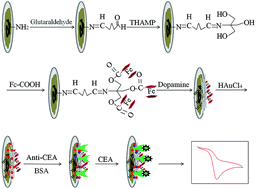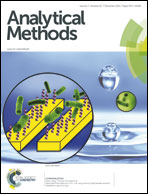Multi-walled carbon nanotubes–chitosan with a branched structure modified with ferrocenecarboxylic acid for carcinoembryonic antigen detection
Abstract
In this article, a novel electrochemical immunosensor was proposed based on ferrocenecarboxylic acids (Fc-COOH) connected to the branched structure of an electrode surface for the detection of carcinoembryonic antigen (CEA). The electrode was first modified with multi-walled carbon nanotubes–chitosan (MWCNT–CS) complexes, and the MWCNT–CS coating contains active secondary reaction functional entities that could form covalent bonds with molecules containing carboxyl or aldehyde groups. A large number of Fc-COOH groups were connected to the branched structure of the electrode surface, and then the electrode was further modified with polydopamine (PDA) and gold nanoparticles (AuNPs), which not only provided a favorable microenvironment and increased the loading capacity of the biomolecules to maintain the activity of the immobilized biomolecules, but also enhanced the conductivity and charge-transport properties of the modified electrode. Under optimal conditions, the immunosensor showed a low limit of detection (0.002 ng mL−1) and a wide linear range (0.01–80 ng mL−1). With the merits of acceptable stability, high sensitivity, the wide linear range and the low detection limit, the new immunosensors show great potential in the field of analytical applications.


 Please wait while we load your content...
Please wait while we load your content...